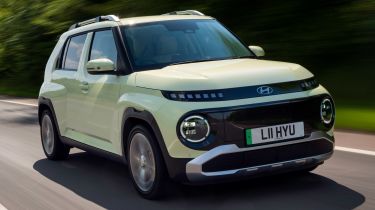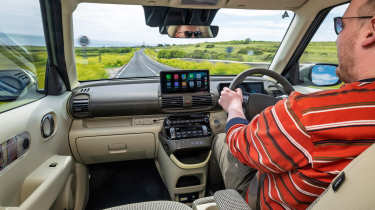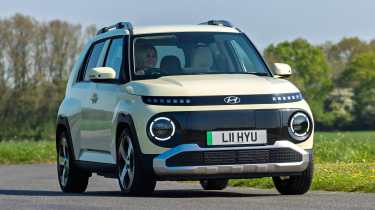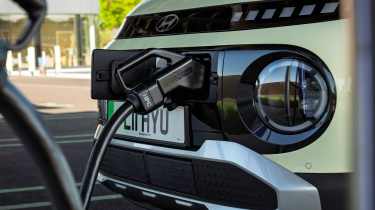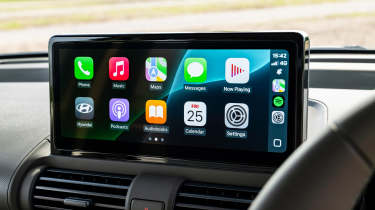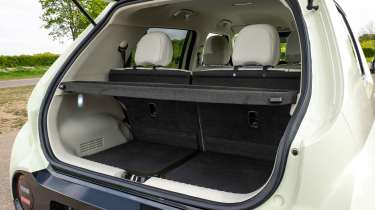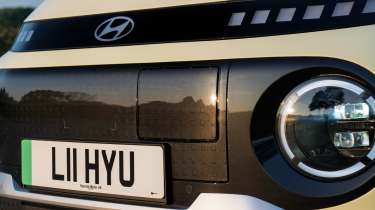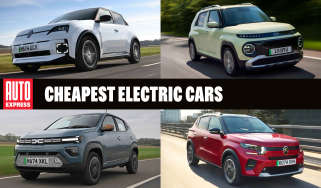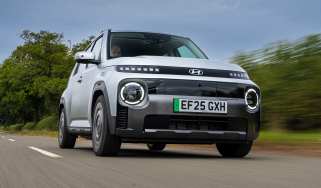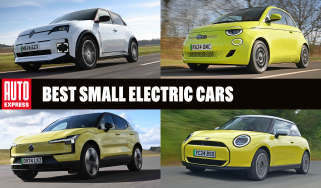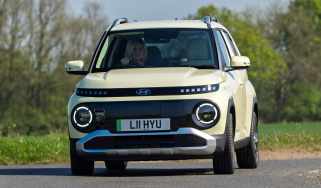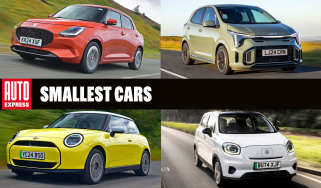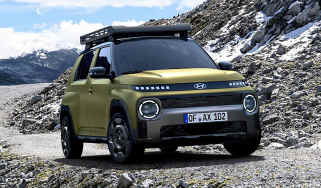Hyundai Inster review
The quirky, half-pint Hyundai Inster is a remarkably versatile, efficient and very lovable EV

Our opinion on the Hyundai Inster
The Hyundai Inster is a very charming and lovable small car that’s so spacious it feels almost like a Tardis on wheels – the cartoonish proportions and boxy shape help achieve that, and turn heads in the process. Meanwhile, the effortlessly efficient powertrain highlights Hyundai’s expertise in the field of electric cars once again. However, the plastic-heavy interior is a letdown, and based on our time behind the wheel, we feel the similarly priced Renault 5 is a more refined and sophisticated car.
About the Hyundai Inster
Ever heard of Casper? Not the friendly ghost, the Hyundai Casper. It’s a small, quirky city car that the brand only sells in its home market of South Korea. We actually got to drive the boxy little bundle of fun back in 2022, when we first heard rumblings about an electric version that might come to Europe to rival the reborn Renault 5 and Volkswagen’s entry-level EV, which we’re still waiting for.
Nearly three years on, and rather than the Casper, the rather adorable Hyundai Inster has finally arrived in the UK. It joins the brand’s very successful line-up of electric cars, including two former Auto Express Car of the Year winners: the space-age Hyundai Ioniq 5 and the very capable Hyundai Kona Electric. There’s also the Hyundai Ioniq 6 saloon, and the huge Hyundai Ioniq 9 seven-seat SUV.
Used - available now

2026 Hyundai
Inster
1,699 milesAutomaticElectric
Cash £20,845
2026 Hyundai
Inster
530 milesAutomaticElectric
Cash £21,120
2026 Hyundai
Inster
2,055 milesAutomaticElectric
Cash £20,297Ordering an Inster should be a straightforward process, because there are only three trim levels to choose from – 01, 02 and the 4x4-inspired Hyundai Inster Cross – and two battery sizes. The most basic model gets a 42kWh ‘Standard Range’ unit, while the rest feature a 49kWh ‘Long Range’ pack. However, it’s worth noting that the Inster is strictly a four-seater, like the Dacia Spring.
Hyundai Inster prices and latest deals
If it wasn’t obvious, the Inster is now Hyundai’s entry-level EV, and is available from around £23,500. That’s a few hundred pounds more than the base R5, and a little higher than the Citroen e-C3, which is a previous Car of the Year award winner and now starts from just over £22k. Meanwhile, its much funkier sister car, the Fiat Grande Panda EV, is priced from over £21k.
If you're interested in purchasing a Hyundai Inster, we can assist you. Configure your ideal Hyundai Inster now to get top offers from local dealers, check out the latest Hyundai Inster leasing deals or search for used Hyundai Inster models with our Find A Car service. You can even sell your existing car for a great price with Auto Express Sell My Car.
Performance & driving experience
Pros |
|
Cons |
|
The Inster benefits from not only Hyundai’s expertise when it comes to producing excellent electric cars, but also the simple fact that this is a very narrow car. Much narrower than its French foes, in fact. Its slim figure makes you feel like you can thread the Inster through any gap in traffic or sneaky side road you fancy. Although its decent motorway manners mean you needn’t feel confined to only city driving.
| Model | Power | 0-62mph | Top speed |
| Inster 42kWh Standard Range | 96bhp | 11.7s | 87mph |
| Inster 49kWh Long Range | 113bhp | 10.6s | 93mph |
| Inster Cross | 116bhp | 10.6s | 93mph |
Performance, 0-60mph acceleration and top speed
Buyers can select one of two powertrains. The entry-level model is only available in the base 01 trim, which drives the front wheels with a single 96bhp motor – enough for a 0-62mph time of 11.7 seconds and an 87mph top speed. Sitting above that is a 113bhp option – available with all three Inster trim levels – which cuts the 0-62mph time by 1.1 seconds and adds 6mph to the top speed. Both versions have the same peak torque of 147Nm.
We’ve driven the more powerful option of the two, and performance is perfectly adequate for a car in this class; indeed, it’s far faster and more responsive than similarly sized petrol-powered city cars and superminis, Hyundai’s own i10 and i20 included. Predictably, the powertrain does its best work at low speeds, where the instant torque from the electric motor lets the Inster leap forward with plenty of enthusiasm, yet the power always remains easy to modulate.
Town driving, visibility and parking
The upright windscreen and huge side windows, combined with the stubby front end with its flat bonnet, mean the view of the road ahead is excellent. Rear visibility is good too, but the thick C-pillars create a sizable blind spot when looking over your shoulder. Hyundai’s solution is exterior cameras that show what's in that blind spot when you indicate. We think it's a terrific feature, but for some bizarre reason, it's only found on the range-topping Inster Cross.
Ride comfort is impressively composed for a car with such a short wheelbase, too. Hyundai’s EVs use steering wheel-mounted paddles to alter the strength of the motor regeneration – a feature that we really like. Several settings between full freewheeling and one-pedal driving can be easily selected on the go – there’s no need to dip into a fiddly touchscreen sub-menu, as is the case with some of its rivals.
However, when coming to a stop with motor regen, the transition between this deceleration and the car’s low-speed creep can be rather jerky.
The turning circle is 10.6 metres, which is decent and the same as the Citroen e-C3. But we’d expect it to be tighter, especially considering that the Skoda Elroq – a much larger family SUV – has a 9.3-metre turning circle.
The low-speed ride in the Inster is nice and soft, but hitting a pothole can send jolts through the cabin. This is partly due to the dinky wheelbase, but also – we suspect – partly due to the relatively unsophisticated torsion beam suspension at the rear.
Country road driving and handling
While the 113bhp motor doesn’t deliver the rapid acceleration that some drivers have come to expect from electric cars, it’s sufficient to make the Inster feel lively enough to keep pace on an open road. The handling is safe rather than exciting, with roll kept well in check, despite the tall body. Grip is reasonable, but when it runs out, the front end tends to gently lose traction first.
Motorway driving and long-distance comfort
At high speeds, the Inster’s refinement starts to be shown up by rivals such as the Renault 5. The main issue is road noise, with tyre roar not as well suppressed inside the cabin as in some of its competitors, wind noise around the roof rails and door mirrors also makes its presence felt, too.
It’s worth noting that the Inster’s refinement still compares well with the i10’s, because the lack of a petrol engine buzzing away in the background makes long trips less tiring here.
“The Hyundai’s natural-feeling steering makes it more fun to drive than the BYD Dolphin Surf, but the latter is quieter at motorway speeds.” - Alex Ingram, chief reviewer.
Range, charging & running costs
Pros |
|
Cons |
|
Although the Inster’s battery sizes are called ‘Standard Range’ and ‘Long Range’, there isn’t a vast difference between them. Hyundai says the 42kWh battery used by the most basic model (which we’ve yet to sample) will provide up to 203 miles of range, while the 49kWh unit is good for 229 miles on a single charge.
Key rivals like the Renault 5 and MINI Cooper Electric offer more range on paper, but the Hyundai makes up for that by being very efficient on the road. We weren’t trying to maximise range when we put the Inster through its paces, mostly on winding country roads and dual-carriageways with the air-con on max, yet the car still achieved 4.0 miles per kWh – better than we’ve been seeing from the Renault 5 on our test fleet.
Based on that average, the Inster could offer a real-world range of 196 miles from the 49kWh battery. Spend a little less time with the pedal to the metal, and we can guarantee that the efficiency figure will climb even higher.
Most people buying a car like this won’t be too worried about lightning-fast charging speeds, which is good because the maximum charging speed is 85kW, or 73kW in the smaller-battery model. That fails to match the 100kW or so rivals can hit, but it still only takes around half an hour to go from 10-80 per cent on a suitably speedy rapid charger for both battery sizes. Those charging at home using a conventional 7.4kW wallbox will find it'll take just over six hours to fully recharge the Standard Range Inster, while the Long Range version takes around 7.5 hours.
| Model | Battery size | Range | Insurance group |
| Inster Standard Range | 42kWh | 203 miles | 21 |
| Inster Long Range | 49kWh | 229 miles | 23-24 |
| Inster Cross | 49kWh | 223 miles | 23 |
Insurance groups
Insurance groups start at 21 for the smaller-battery Inster, while the larger-battery cars in 01 and 02 trims sit in group 23. The Inster Cross also sits in group 23.
Tax
With the exception of the first year, where Vehicle Excise Duty rates are absorbed into a car’s ‘on the road’ price, EVs no longer get the tax breaks that low-emissions cars had previously. From the second year onwards, owners will pay £195 in VED road tax annually.
Depreciation
Residual values aren’t an Inster strong point; figures of around 42 per cent after three years or 36,000 miles mean that its depreciation is steeper than petrol-powered Hyundai i10s and i20s, which keep closer to 50 per cent of their starting prices.
Interior, design & technology
Pros |
|
Cons |
|
The boxy shape, bulbous wheelarches, comically large circular lights and extremely short overhangs were all features of the original Hyundai Casper. However, the square pixel lighting on the front and rear is taken from Hyundai’s other electric cars, such as the Ioniq 5 and Kona Electric. The charging port being located in the nose is something else we’ve seen in the brand’s EVs before.
We like the rather cartoonish design of the Inster, which reminds us of the Suzuki Ignis, and some of the wacky kei cars that are sold exclusively in Japan. This is a car that suits a more vibrant paint finish than the standard black, and thankfully, Hyundai offers various hues and finishes, with the stand-outs being Sienna Orange and Buttercream Yellow. Base models are fitted with 15-inch wheels, while the rest of the range gets a more impressive set of 17-inch diamond-cut rims.
Interior and dashboard design
Those who have been drawn to the cheeky looks of the Inster on the outside are likely to be hoping for more of the same from the cabin – but the interior is a little more plain and sensible. The high-set dashboard design allows the main controls to fall easily to hand, though, and we’re glad to see that there are big, chunky buttons for adjusting the temperature and the fan speed.
To help brighten up the interior, you can specify a beige interior with a houndstooth fabric used across the seats – this dramatically lifts the cabin’s appeal, if not its practicality.
Materials and build quality
At the lower reaches of its range, Hyundai tends to compromise on interior quality a little more than some of its rivals – and that’s the case for the Inster, too. Aside from a bit of squidgy trim on the side of the armrests, there are next to no soft-touch materials throughout the cabin.
This is disappointing as rivals like the Renault 5 manage to pepper in some fabrics or other materials in places. At least the overall build quality is solid, and we couldn’t hear any rattling or squeaking from the plastic trim in our test car.
Infotainment, sat-nav and stereo
Apple CarPlay and Android Auto are standard, as is the 10.25-inch touchscreen mounted on top of the dashboard, which we wish had been positioned lower to make it easier to reach.
The Inster doesn’t feature Hyundai’s very latest software, instead it uses an infotainment system that’s actually two generations old. Sure, it doesn’t look quite as slick or modern as the stuff in the brand's newer models, but the benefit of using older software is that Hyundai has ironed out all the kinks and bugs. It also gets the job done, and the graphics are clear; however, there are numerous menus to navigate through, and they can be quite laggy.
“My biggest gripe though is that, despite the litany of buttons scattered across the dashboard, not one of them can turn off the car’s various driver-assistance systems (ADAS) and their irritating bonging.” - Ellis Hyde, news reporter.
Boot space & practicality
Pros |
|
Cons |
|
Hyundai has squeezed every possible millimetre of cabin space out of the Inster, managing to create a 3.8-metre-long city car with the Tardis-like quality of allowing six-foot adults to comfortably sit in the back of it. There are only four seats, however, and cabin storage is neither here nor there, with spaces on the dashboard and in the centre console to store odds and ends, but the door bins are only large enough for a wallet.
Dimensions and size
Measuring 3,845mm long, 1,610mm wide and 1,575mm tall, the Hyundai Inster is a little bit longer than the Dacia Spring, but shorter than its more direct rivals such as the Citroen e-C3, Renault 5 and Fiat Grande Panda.
| Dimensions comparison | |||
| Model | Hyundai Inster | Renault 5 | Dacia Spring |
| Length | 3,845mm | 3,922mm | 3,701mm |
| Width | 1,610mm | 1,774mm | 1,583mm |
| Height | 1,575mm | 1,498mm | 1,519mm |
| Wheelbase | 2,580mm | 2,540mm | 2,420mm |
| Boot space | 280 litres | 277 litres | 308 litres |
Seats & passenger space
Hyundai has made the most of the narrow cabin by in effect joining the front seats at the hip. There’s no gap here; the fabric reaches out to produce what is basically a bench seat that’s split in the middle.
The seat offers plenty of adjustment, and while it’s a bonus that the steering wheel adjusts for both reach and rake, some testers wished it would extend out a little more. The driving position is also set fairly high, which some buyers will enjoy.
The driver’s side of the seat houses two cup-holders, one example of many storage spaces Hyundai has crammed into this very small car. A smartphone shelf sits just beneath the heating controls, and its position high on the dash helps make it easy to reach. Another smaller storage bin sits below it, while an open shelf is located above a fairly standard glovebox. The door bins are very slim, though.
It’s clear that Hyundai wanted to promote space and versatility with the Inster, and the result is excellent – few cars anywhere near this size offer so much space.
Rear knee room is fantastic and against a tape measure, the Inster offers within a few millimetres of what back-seat passengers get in a Hyundai Ioniq 5, which is incredible considering it’s almost 80cm longer in terms of exterior dimension. There’s even a sliding and reclining rear bench in the Inster (not on the base 01 trim) if you wish to sacrifice some knee room for boot space. Impressively, the Inster actually pips the Ioniq 5 for headroom.
Of course, the EV’s narrow body means something has to give, and it’s that the Inster’s rear bench is strictly for two – there’s no centre seat – but it’s hard to knock it for that.
Boot space
The Inster’s 238-litre boot is okay, rather than outstanding, for a car of this size. But slide the rear bench forward, and that figure grows to 351 litres. This does make knee room a little tight in the back, but unlike its rivals, the Inster at least gives owners the option to make that compromise.
Fabric panels attached to the parcel shelf clip to the back of the rear seats, so whichever position that they are in, the contents of the boot are hidden from view. A 50:50 split drops the rear seat down to increase the total volume to 1,059 litres, which is slightly better than rivals such as the BYD Dolphin Surf.
“The boxy shape and clever packaging provide an astounding amount of headroom and ample legroom for six-foot-tall adults to sit comfortably in the back, as I can attest.” - Ellis Hyde, news reporter.
Reliability & safety
Pros |
|
Cons |
|
The Inster received a four-star score from Euro NCAP when it was tested in 2025. That’s one star short of the maximum, but puts the Hyundai on par with most of its closest rivals, including the Renault 4 and Renault 5.
There’s lots of safety kit, including seven airbags as standard (the Citroen e-C3 gets six), plus some driver-assistance systems, such as lane-keeping assist, a driver-attention monitoring system, and forward collision avoidance assist. But only the top-spec Cross comes with a blind-spot monitoring system.
Based on owners’ feedback from our 2025 Driver Power satisfaction survey, Hyundai was 20th (out of 31) in the best manufacturer rankings, which is 10 places higher than BYD and 11 up on last-place MG. Yet it’s well short of Renault, which ranked in sixth position.
| Euro NCAP safety ratings | |
| Euro NCAP safety rating | 4 stars (2025) |
| Adult occupant protection | 70% |
| Child occupant protection | 81% |
| Vulnerable road user protection | 70% |
| Safety assist | 67% |
Buying and owning
- Best buy: Hyundai Inster 49kWh 02
The entry-level Hyundai Inster comes well equipped with dual 10.25-inch displays, Apple CarPlay, Android Auto, keyless entry, a reversing camera and a smattering of safety kit. However, we recommend upgrading to the 02 trim, as it features a larger battery for extended range, a sliding and reclining rear bench for maximum versatility, and additional equipment, including heated front seats and a heated steering wheel.
Hyundai Inster alternatives
The Inster is Hyundai’s champion in the small electric car class, which is more competitive than ever right now. The newest contenders include the reborn Renault 5 and incoming Renault 4, the MINI Cooper Electric, BYD Dolphin and a previous Auto Express Car of the Year, the Citroen e-C3. There are also Citroen’s numerous siblings to consider, including the funky Fiat Grande Panda, the more practical Citroen e-C3 Aircross, and the Vauxhall Frontera. The Peugeot E-208 and Vauxhall Corsa Electric are also still on offer, but they’re a bit long in the tooth now.
Frequently Asked Questions
The Hyundai Inster is incredibly spacious and versatile for such a small car, comes well equipped and proved to be very efficient during our testing. Its ability to put a smile on your face is a handy bonus.
Deals on the Inster and alternatives
